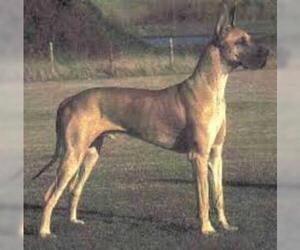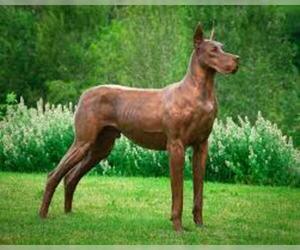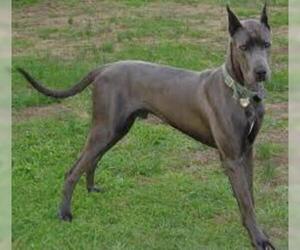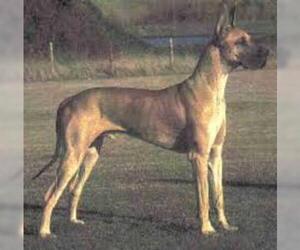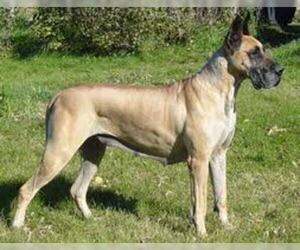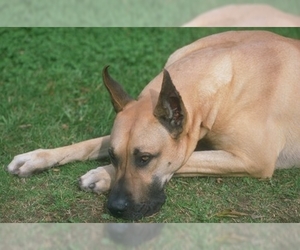
All about Great Dane dog breed
A.K.A. :German Mastiff, Deutsche Dogge, Dänische Dogge, Tigerdogge, Ulmer Dogge, Englische Dogge, Grand Danois, Dogue Allemand, Great German Dog, Apollo of Dogs, King of Hounds, Gentle Giant, Dane
Size
Grooming requirements
Exercise requirements
Good with other dogs
Watchdog ability
Energetic
Training requirements
Playful
Affectionate
Good with other pets
Good with children
Good with strangers
Winter
Summer
Healthiness
Protective
Life Span
| Pure Breeds | Member |
| Breeds A - Z | G |
| Breeds by Group | Flock Guards & Mastiffs Working |
| Breeds by Trait | Good With Kids Low Shedding |
| Overview: | The Great Dane is an impressive and regal breed, often dubbed the "Apollo of Dogs" for its dignified stature and noble appearance. Originating in Germany, where it was historically bred for hunting boar, this giant breed is renowned for its immense size and striking presence. Physically, Great Danes are characterized by their tall, muscular build, short coat (available in various colors like fawn, brindle, black, blue, and harlequin), and expressive eyes. Despite their formidable size, they possess a surprisingly gentle and affectionate temperament, making them wonderful family companions. They are known for being patient with children and generally get along well with other pets. While their size might suggest otherwise, Great Danes can adapt to apartment living if provided with sufficient daily exercise, as they are not overly energetic indoors. However, prospective owners should be aware of certain health considerations, including a predisposition to bloat (gastric dilatation-volvulus), hip dysplasia, and certain heart conditions, necessitating careful breeding and regular veterinary check-ups. Overall, a Great Dane offers a loving and loyal addition to the right home. |
F.A.Q.
All You Need to Know About the Great Dane Breed
The Great Dane, often called a “gentle giant,” is a majestic breed known for its impressive size and sweet nature. Originating from Germany, not Denmark, they were historically bred for hunting wild boar. Physically, they boast a powerful, muscular build with a sleek, short coat that comes in various colors, including fawn, brindle, blue, and harlequin. Despite their immense stature, Great Danes are incredibly affectionate and loyal, making them excellent family pets, even with children. While their size might suggest otherwise, they can adapt to apartment living if provided with daily walks and mental stimulation, as their exercise needs are moderate. Grooming is minimal, requiring only occasional brushing. Prospective owners should be aware of common health issues like bloat, hip dysplasia, and heart conditions. Owning a Great Dane means welcoming a loving, devoted companion into your home.Great Dane Weight: Average Size & Healthy Weight for Great DaneThe average healthy weight for adult Great Danes is between 110 to 175 pounds.* Males (Great Dane weight): Typically range from 140 to 175 pounds.* Females (Great Dane weight): Generally weigh between 110 to 140 pounds.This range reflects the healthy weight for a well-built adult Great Dane, with males being noticeably heavier than females.
Curious about Great Dane height? You've come to the right place! When it comes to the majestic Great Dane, their impressive stature is one of their most defining characteristics. Understanding their typical adult height is crucial for potential owners, so let's break down the average size of these gentle giants.
How Tall is a Great Dane? Understanding Great Dane Height
The average height of a Great Dane is measured at the shoulder (withers) when the dog is fully grown. While individual genetics play a role, here’s a general guideline for what you can expect:- Male Great Danes: Typically stand between 30 to 32 inches tall at the shoulder. Some particularly large males may even exceed this range.
- Female Great Danes: Are generally a bit smaller, with an average height ranging from 28 to 30 inches tall at the shoulder.
Great Dane colors encompass a wide range, impacting both appearance and pricing. The American Kennel Club (AKC) recognizes several primary colors: Fawn (yellow-gold with a black mask), Brindle (fawn with black stripes), Blue (steel blue/gray), Black (glossy black), Harlequin (white with torn black patches), and Mantle (black with a white chest, muzzle blaze, and tail tip). These are the most common and accepted for show.
Beyond the AKC recognized Great Dane colors, several other stunning, though often less common, variations exist. Merle, while not showable as a primary color, often appears as a base for Harlequin (blue merle). Solid merle Great Danes have a marbled or speckled coat pattern, and breeding two merles can lead to health issues. Chocolate and Lilac (a dilute chocolate) are considered rare coat types and are not AKC-recognized. Cream and White Great Danes are also seen; true white Danes are often associated with genetic issues from merle breeding, while cream is a dilute fawn. These exotic Great Dane variations often command higher prices due to their rarity, but potential buyers should research their health implications and understand they may not be suitable for conformation showing.The Great Dane personality is famously gentle and affectionate, often described as a "gentle giant." They are incredibly friendly, displaying immense loyalty to their families, and are generally very sociable, enjoying the company of people and other well-behaved pets. Despite their imposing size, their temperament of Great Dane is typically calm and patient, making them excellent companions. They are surprisingly adaptable to apartment living, provided they receive adequate daily exercise, as they thrive on being close to their loved ones. Great Danes are generally very good with children, often forming strong bonds and acting as patient guardians, though supervision is always recommended due to their size. With proper socialization, they can coexist peacefully with other dogs and even cats.
Great Dane Temperament: Gentle Giant CompanionThe Great Dane temperament is famously gentle, earning them the nickname "Apollo of Dogs." They are incredibly friendly and sociable, forming strong bonds with their families and generally welcoming to strangers. Loyalty is a hallmark trait, making them devoted companions.Despite their immense size, Great Danes are surprisingly adaptable and, with proper exercise, can do well in apartment living. However, ample space for movement is always preferred. They are renowned for their patience and gentleness with children, often acting as "nanny dogs," though supervision is always advised due to their size. Their nature extends to other pets, as they are typically amiable and can coexist peacefully with other dogs and cats, especially when socialized from a young age.While intelligent, Great Danes can exhibit a touch of stubbornness, requiring consistent and positive reinforcement training. They are also quite sensitive and respond best to gentle guidance rather than harsh corrections. They thrive on human companionship and can be prone to separation anxiety if left alone for extended periods. Overall, the Great Dane's personality traits define them as loving, calm, and majestic companion dogs.
Great Dane Care & MaintenanceGreat Dane care involves several key areas for this gentle giant. Despite their size, Great Danes are a low-energy dog breed indoors, making them suitable for apartment living with adequate daily outdoor activity.Grooming Needs: Their short coat is easy to maintain. Weekly brushing with a rubber curry brush or shedding blade is usually sufficient to remove loose hair and keep their coat healthy. Regular nail trims (every 2-4 weeks) are crucial to prevent discomfort and splayed feet.Exercise Limitations: While they enjoy short walks and playtime, vigorous or prolonged exercise should be avoided, especially in puppies, to protect their developing joints. They are prone to bloat (gastric dilatation-volvulus), so avoid strenuous activity immediately before or after meals.Dietary Considerations: Great Danes require a high-quality, large-breed dog food formulated for giant breeds to support their rapid growth and maintain a healthy weight. Follow feeding guidelines carefully to prevent obesity, a common health concern that exacerbates joint issues. Divide daily meals into two or three smaller portions to reduce the risk of bloat.Their large, floppy ears require weekly cleaning with a vet-approved ear cleaner to prevent wax buildup and infections.Climate Sensitivity: Great Danes are sensitive to extreme temperatures. Due to their short coat, they can get cold easily in winter and should be provided with a coat or sweater when outdoors in chilly weather. While not brachycephalic, their large size and activity limitations mean they can overheat in hot weather, so always provide shade and fresh water.Common Health Concerns & Prevention: Beyond bloat, be aware of skin issues like allergies, which can often be managed with proper diet and veterinary care. Dental care is paramount; daily brushing or dental chews help prevent periodontal disease. Regular veterinary check-ups are essential for monitoring overall health tips for Great Dane and addressing concerns like hip/elbow dysplasia and cardiomyopathy, which are more prevalent in giant breeds. Weight management is crucial throughout their lives to minimize stress on their joints.
Great Dane Activity Level: How Active Are Great Danes?The Great Dane activity level is often misunderstood. While they are a giant breed, Great Danes balance short bursts of energy with long periods of rest. They are not typically high-energy dogs that require constant intense activity.Typical Energy Levels: Great Danes possess a moderate energy level. They enjoy their comfort and are often described as "couch potatoes" indoors, but they also need regular opportunities to stretch their long legs.Daily Exercise Needs: To maintain their health and happiness, Great Danes require at least 30-60 minutes of moderate daily exercise. This can include a brisk walk, supervised playtime in a secure yard, or short, engaging play sessions. It's crucial to avoid over-exercising puppies, as their developing joints are vulnerable.Playtime Preferences: Great Danes generally enjoy interactive playtime, such as chasing a ball (for short durations), gentle tug-of-war, or simply romping with their family. They appreciate mental stimulation through puzzle toys and training.Limitations Due to Brachycephalic Anatomy (Incorrect): It's important to clarify that Great Danes are NOT a brachycephalic breed. Brachycephalic breeds are those with short, "squished" noses (like Pugs or Bulldogs) which can lead to breathing difficulties. Great Danes have long muzzles and do not experience brachycephalic-related exercise limitations. However, due to their size, care should always be taken to avoid strenuous exercise in hot weather to prevent overheating in any dog.Suitability for Families: Great Danes are adaptable. They can be suitable for active families who enjoy regular walks and outdoor activities, but they are also well-suited for low-energy households that can provide consistent, moderate exercise needs. Their calm demeanor indoors makes them excellent companions for many lifestyles, provided their exercise needs are met. Ultimately, Great Danes thrive in homes where they receive attention and companionship, regardless of the family's exact activity level, as long as their basic exercise needs are consistently fulfilled.
Breed Breakdown: What Experts Say About the Great Dane
I'd rate the "Size" trait of the Great Dane breed a 10.Great Danes are undeniably massive, consistently ranking among the largest dog breeds. Their average height can reach 30-34 inches at the shoulder, with some individuals exceeding that. Weights typically range from 110 to 175 pounds, and their lean, muscular body structure makes them appear even more imposing. When compared to the vast majority of other companion dogs, from Chihuahuas to Labradors, Great Danes dwarf them in every dimension. They are absolutely not suited for apartment living, frequent travel (unless in a very large vehicle), or households with significant space constraints. They require ample room to stretch, move around without knocking things over, and simply exist comfortably.
I would rate the Great Dane's "Grooming Requirements" a 4 out of 10.While their short, sleek coat might initially suggest extremely low maintenance, there are several factors that elevate their grooming needs beyond a simple "wash and go." They are moderate to high-shedders, especially seasonally, meaning regular brushing (several times a week) is necessary to manage loose hair and keep their coat healthy. Their large size necessitates more effort for tasks like bathing, even if it's not a frequent occurrence. While they don't have extensive skin folds requiring specialized daily cleaning, they can be prone to skin allergies, which might require specific shampoos or topical treatments. Ear cleaning is important to prevent infections, as with many breeds. Their fast-growing nails require consistent trimming, which, again, is a bigger task on a giant dog. Overall, they are relatively easy to care for compared to breeds with long, dense coats or elaborate grooming requirements, but their shedding, size, and potential for specific health considerations prevent them from being considered extremely low-maintenance.
I would rate the Great Dane's exercise requirements at a 6.While they are giant dogs, Great Danes are not high-energy athletes in the same vein as a Border Collie or a Jack Russell Terrier. Their sheer size means they expend more energy with less movement, and they are prone to joint issues if over-exercised, especially during their growth phase. They aren't brachycephalic, so respiratory limitations aren't a concern, but their large size does make them less suited for sustained, high-impact activities like long-distance running or complex agility courses that require quick, sharp turns.They thrive with moderate, consistent activity rather than intense bursts. Daily walks, ideally two per day, of at least 30-60 minutes each, are crucial for their physical health and mental well-being. This helps maintain muscle tone, prevents obesity, and provides mental stimulation through exploring scents and sights. They also enjoy playtime in a securely fenced yard, engaging in games of fetch with soft toys or gentle romps with their owners. While they are capable of some light jogging, it should be done cautiously and on softer surfaces. Structured routines are beneficial, but these routines should prioritize duration and consistency over intensity. They are not a breed that can thrive with minimal activity; insufficient exercise can lead to boredom, destructive behaviors, and contribute to weight gain and joint problems. They are generally adaptable to various types of exercise as long as it's not overly strenuous or impactful, and they certainly appreciate a good nap after their activity.
I'd rate the Great Dane's "Watchdog Ability" at a 6.While their imposing size alone can be a deterrent, Great Danes aren't typically the most vocally reactive or aggressively territorial watchdogs. They are quite alert to their surroundings and will certainly notice unfamiliar sounds or people. Their bark, when they do use it, is deep and resonant, which can be an excellent early warning signal and potentially enough to make an intruder think twice. However, their primary instinct isn't usually to aggressively confront. Instead, they are more likely to stand between their family and a perceived threat, using their body as a barrier and their imposing presence to make a statement. They are loyal and protective of their family, but their willingness to actively deter an intruder beyond a warning bark and a watchful stare is often dependent on individual temperament and training. They are more capable of providing meaningful early warnings through their alertness and impressive bark than being a consistently active, confrontational deterrent, often being more of a gentle giant until a true threat is perceived.
I would rate the "Good with Other Dogs" trait of the Great Dane breed as an 8 out of 10.Great Danes generally possess a remarkably placid and tolerant temperament, which often extends to their interactions with other canines. Their gentle giant nature means they are typically not prone to aggression or dominance displays, especially when properly socialized from a young age. They often exhibit a surprising level of patience with smaller, more boisterous dogs and can adapt well to various energy levels, often choosing to observe rather than actively participate in high-intensity play. In multi-dog households, they usually integrate smoothly, often becoming the peacemaker or the one who calmly supervises the group.However, while naturally inclined towards friendliness, their large size and strength mean that early and consistent socialization is still crucial. Without it, a Dane, like any dog, could become anxious or unsure around unfamiliar dogs, potentially leading to misunderstandings, though true aggression is rare. They thrive in canine company and generally enjoy having other dogs around, often forming strong bonds. While typically very sociable, careful introductions are still recommended for any new dog, as with any breed, to ensure a smooth transition. They usually coexist peacefully and often prefer having canine companions.
I would rate the "Energetic" trait of the Great Dane a 3 out of 10.Great Danes are surprisingly low-energy for their size. While they enjoy a good romp and bursts of playful activity, they are largely a laid-back and even couch-potato breed. Their typical activity level is moderate, preferring a few short walks or a good play session over prolonged strenuous exercise. Their endurance is not particularly high, and they are more prone to quick bursts of energy followed by long naps. Playfulness is present, especially when young, but it tends to be more gentle and less frantic than many other breeds. Their need for physical stimulation is moderate; they require regular exercise to stay healthy and prevent boredom, but they don't demand constant activity. They can participate in outdoor activities, but they are not built for extensive athletic endeavors. Compared to other companion dogs, Great Danes are definitely on the more laid-back side. Their brachycephalic anatomy, though less pronounced than some breeds, can affect their stamina and exercise tolerance, making them more susceptible to overheating and breathing difficulties during intense or prolonged physical activity, further reinforcing their preference for a more relaxed pace.
I would rate the training requirements of a Great Dane at a 7 out of 10. While Great Danes are intelligent and generally eager to please their owners, their sheer size and potential for stubbornness prevent them from being considered "easy" to train. They have a decent attention span, especially when motivated by treats or praise, and respond well to positive reinforcement. However, their physical strength means that even playful disobedience can be a major issue, requiring consistent and firm, yet gentle, handling from a young age. Their sensitivity also means harsh training methods are counterproductive and can lead to fear or resentment. Due to their size and the need for early socialization and consistent boundary setting to prevent them from becoming an unruly giant, Great Danes are not truly beginner-friendly. They require an owner who understands the importance of structured routines, has the time and patience for consistent daily training, and is prepared to invest in professional guidance if needed. Their agreeable nature is best harnessed by experienced handling that establishes clear expectations and rewards good behavior consistently.
I would rate the Great Dane's "Playful" trait a 6 out of 10.While not overtly hyper or rambunctious like some terrier breeds, Great Danes are far from inactive. They possess a delightful, often clumsy playfulness that emerges throughout their lives. They genuinely love interacting with their families and can be quite goofy, often initiating games with a nudge of their giant heads or a playful pounce. Their response to toys, especially those that can be tugged or chased, is enthusiastic, and they enjoy a good romp in the yard. However, their energy levels aren't consistently high; they are equally content to lounge on the sofa. They are naturally spirited in bursts, but also possess a laid-back, gentle giant demeanor. They aren't typically "attention-seeking" in an demanding way, but rather appreciate and reciprocate affection and playtime when offered.
I would rate the "Affectionate" trait of the Great Dane breed a 9 out of 10.Great Danes are renowned for their incredibly loving and gentle dispositions, often referred to as "gentle giants." They possess an immense desire for human companionship and thrive on being an integral part of their family. Physical closeness is a hallmark of their affection; they are notorious for attempting to be lap dogs, despite their colossal size, and will readily lean against, sit on, or cuddle with their loved ones. Their loyalty is unwavering, and they are remarkably sensitive to their owners' emotions, often offering comfort during times of distress. It's not uncommon for a Great Dane to follow their family members from room to room, preferring to be in close proximity at all times. They genuinely flourish in an environment rich with affection and can become quite sad or anxious if left alone for extended periods, making them far from independent compared to other companion dogs. They crave and return affection in spades.
I would rate the "Good with Other Pets" trait of the Great Dane a 7 out of 10.Great Danes are generally known for their gentle and amiable temperament, which often extends to other animals. They typically possess a low to moderate prey drive, especially when properly socialized from a young age. Their large size can sometimes be intimidating to smaller pets, but they are rarely aggressive and are more likely to be curious or even a bit clumsy. Resource guarding is not a prominent trait in the breed, though individual dogs can vary. They are naturally sociable and often enjoy the companionship of other animals, particularly other dogs. However, their size and strength mean that early and consistent socialization with a variety of other pets, as well as continued supervision, is crucial. While many Great Danes will coexist peacefully with cats, their playful nature and sheer size can inadvertently overwhelm a smaller feline if not properly introduced and managed. They are highly adaptable in multi-pet households, especially when they grow up with other animals, but training and ongoing supervision are definitely required to ensure harmonious relationships and to prevent accidental injuries due to their enthusiasm and lack of spatial awareness.
Rating the "Good with Children" trait of the Great Dane on a scale of 1 to 10, I would give them an 8.The Great Dane, despite its imposing size, is generally renowned for its gentle and affectionate nature, making it a surprisingly excellent companion for families with children. They possess a remarkably calm temperament and a high degree of patience, which is crucial when dealing with the unpredictable energy of young children. Their playfulness is often a gentle giant type, enjoying a good romp but rarely with aggressive intent. They tend to be quite tolerant of noise and handling, though like any dog, respectful interactions should always be encouraged and supervised. They are naturally gentle and often form strong bonds with children, seeing them as part of their "pack." While their sheer size means accidental bumps are possible, their underlying good nature usually shines through. Early socialization and continued supervision are always recommended, especially with very young children, to teach both dog and child appropriate boundaries, but the breed itself has a strong predisposition to thrive in a family setting without excessive, specialized training to achieve child-friendliness.
The Great Dane's "Good with Strangers" trait rates a solid 8 out of 10. They are naturally quite sociable and welcoming, generally greeting unfamiliar adults with a gentle curiosity rather than suspicion. Their friendly demeanor means they're usually happy to accept attention and are not prone to being reserved or unfriendly, provided they've been properly socialized as puppies. While they possess a protective instinct towards their family and home, their initial reaction to a stranger is more likely to be a wagging tail than a deep guard bark, especially in public or guest-filled environments where they tend to be adaptable and calm. While early socialization is beneficial for any breed, Great Danes typically possess an inherent outgoing nature that makes them comfortable and pleasant around new people without extensive specific training to overcome shyness.
I would rate the Great Dane's "Winter" tolerance at a 2.Great Danes are exceptionally sensitive to cold weather. Their single, short, thin coat offers very little insulation against the cold. While their large size provides some thermal mass, they have relatively low body fat for their size compared to breeds adapted to cold. Their brachycephalic anatomy, though less pronounced than some breeds, can exacerbate breathing difficulties in very cold, dry air. They are highly susceptible to hypothermia, even in moderately cold temperatures, and their large, thin ears are prone to frostbite. Safely enjoying outdoor activity in cold climates is severely limited; even a brief walk can be risky without appropriate protection. They absolutely require special care during winter months, including sweaters or coats for any outdoor excursions, limiting time outdoors, and ensuring a warm, draft-free indoor environment. Unlike many other companion dogs, they cannot tolerate even slightly prolonged exposure to cold without significant risk to their health.
I would rate the Great Dane's "Summer" tolerance at a 3.While not as severely brachycephalic as some breeds, Great Danes do have a slightly flattened muzzle, which can impede efficient panting—their primary method of cooling. Their large size also contributes to a larger surface area to cool and a higher metabolic rate, generating more internal heat. Great Danes are prone to overheating and are at a significant risk of heatstroke, particularly during moderate to high temperatures. They struggle to regulate their body temperature effectively in warm weather. Outdoor activity should be severely restricted to early mornings or late evenings on cooler days, and even then, only for short periods. During hot weather, they absolutely require climate control, meaning they need to be kept indoors in air conditioning. Compared to many other companion dogs, Great Danes necessitate considerable special care in the summer months, demanding constant vigilance from their owners to prevent heat-related illness.
I would rate the Great Dane's "Healthiness" trait a 3 out of 10.While stunning and devoted, the Great Dane is unfortunately not a robust breed regarding health and is considered quite high-maintenance in this regard. Their impressive size comes with significant health disadvantages, leading to a notably short average life expectancy of only 7 to 10 years, which is poor compared to most other companion dogs. They are genetically predisposed to a multitude of severe and often life-threatening conditions. Bloat (gastric dilatation-volvulus) is a terrifying and rapid killer for the breed, demanding immediate veterinary intervention and often prophylactic surgery. Joint problems are rampant due to their rapid growth and sheer weight, with hip and elbow dysplasia being common, as well as osteosarcoma (bone cancer). Cardiomyopathy, a serious heart condition, is also prevalent. Other concerns include Wobbler Syndrome, various cancers, and eye conditions. While responsible breeding can mitigate some risks by screening for certain genetic conditions and preventive care like controlled growth, appropriate exercise, and a good diet are crucial, they only go so far in a breed with such inherent health vulnerabilities. They are far from a generally robust breed and require a significant commitment to proactive health management and potentially high veterinary costs.
I would rate the "Protective" trait of the Great Dane at a 5 out of 10.While Great Danes are incredibly loyal and devoted to their owners, and their sheer size and imposing presence can certainly be a deterrent, they are not inherently aggressive or highly territorial. They are generally alert to new sounds and sights, and their deep bark can be quite effective as an initial warning. However, their reaction to strangers is more often characterized by curiosity and a desire to be friendly rather than immediate suspicion or aggression. They are more likely to greet a stranger with a wagging tail than an attempt to defend the household. As a watchdog, their size and bark are valuable, but as a true guard dog capable of offering meaningful physical protection in a confrontational household setting, they are typically not suited. They are primarily companion dogs who might provide an initial deterrent through their appearance and bark, but their gentle and sweet nature usually overrides a strong protective drive.
I would rate the "Life Span" trait of the Great Dane breed a 2 out of 10.Great Danes are unfortunately known for their significantly shorter average lifespan compared to most other companion dog breeds. Their average life expectancy typically ranges from 7 to 10 years, which is considerably less than the 10-14 year average for many other large breeds, and even shorter compared to smaller dogs that often live into their mid-teens. This short lifespan is largely due to their rapid growth and immense size, which puts a tremendous strain on their bodies. They are highly predisposed to serious health issues, including dilated cardiomyopathy (a leading cause of death), bloat (gastric torsion), and various cancers like osteosarcoma. While responsible breeding and excellent veterinary care can certainly help manage some conditions and potentially extend their lives by a year or two, they cannot fundamentally alter the genetic predispositions and physiological stresses inherent to the breed's giant stature. Therefore, in comparison to other companion dogs, Great Danes are considered very short-lived.
Great Dane Puppies for saleSee all puppies for sale
Great Dane Dogs for adoptionSee all dogs for adoption
Great Dane BreedersSee all breeders
Similar Dog Breeds for Great Dane
Breed Mixes of Great Dane
Quick Breed Selector 0 - not important, 1 - smallest, 10 - largest
Variants & Mistakes :Greate Dane, Grat Dane, Great Daine, Graet Dane, Grea Dane, Gret Dane, Great Dan, Great Dne, Great Daen, Greay Dane, Gread Dane, Grate Dane, Greyte Dane, Greatdan, Greatdane, Great Deign, Great Dein, Grait Dane, Grate Dain, Greate Daine, Grat Dain, Great Dn, Grea Dan, Greatain Dane, Grate Dan, Great Dayne, Greet Dane, Greaet Dane, Gret Daine, Graet Daine, Grea Daine, Grate Dayne, Greay Daine, Gread Daine, Greight Dane, Greight Daine, Graight Dane, Graight Daine, Gret Dayne, Grea Dayne, Gread Dayne, Grait Dayne, Gret Dan, Gread Dan, Greay Dan, Graet Dan, Grait Dan, Greight Dan, Graight Dan, Greight Dayne, Graight Dayne

